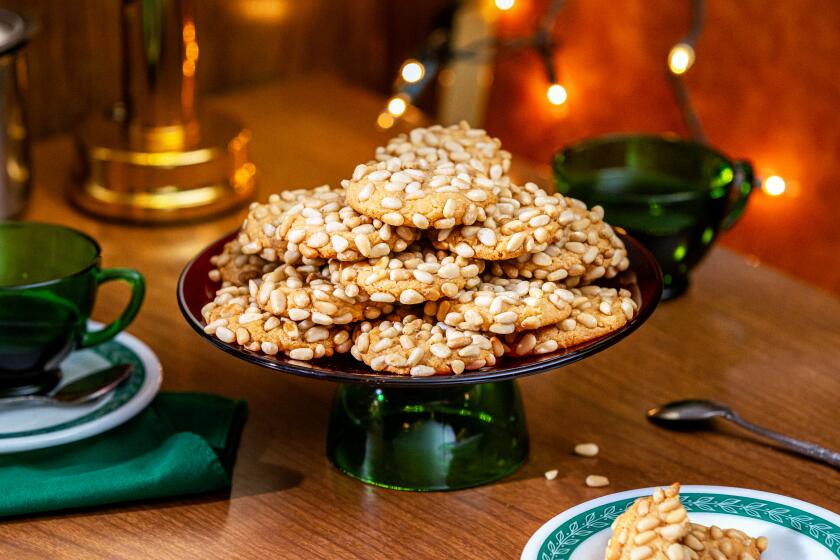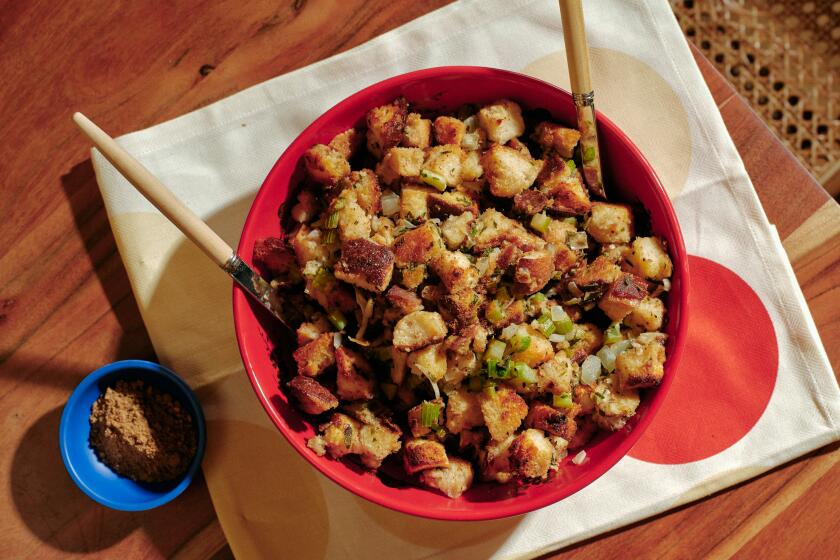Daily bread
- Share via
This recipe is a simple one. It’s what I make when I want bread I can knock together quickly and vary at will — I might make a plain batard, rosemary baguettes, a dozen currant rolls — the possibilities are endless. No overnight rising, no three-day levain, no sourdough experiments: I save those for my long weekend homages to Nancy Silverton. This basic bread is so easy that you won’t even need the recipe after you make it a few times. Once you get the simple chemistry, it becomes second nature.
In a large mixing bowl, stir together 2 cups of warm water (120 to 130 degrees), the yeast, sugar and 1 cup of the flour. Let sit 15 minutes. (If the yeast doesn’t activate, you have to throw this out and start over, though this rarely happens.)
With a wooden spoon or bread cutter or your hands, mix in the olive oil, wheat germ and 3 cups of flour. Gradually add the salt and more of the flour, letting the dough come together.
Knead the dough on a floured board or table, adding the rest of the flour as needed; be careful not to get the dough too dry. (If using herbs or other flavorings, knead them in at this point, adding more flour if the dough gets too sticky.) Once the flour is incorporated, knead the dough for about 10 minutes, until elastic; test with the “windowpane method” (stretch a piece of dough between your fingers: if it tears easily, it needs more kneading) or by sticking your finger into the dough to see if it bounces back.
Shape the dough into a round and put it into a bowl coated with about one-half teaspoon of olive oil (coat the dough’s surface too). Cover with plastic wrap and let rise, 1 1/2 hours. Punch down the dough, shape it back into a ball, and let it rise for the second fermentation, about one-half hour.
Punch down the dough again, divide it into two portions, and shape each portion into a batard. Press the dough into a rectangle, roughly 10 inches by 7 inches. With the long side of the rectangle facing toward you, grasp the upper corners of the dough and fold them to meet in the center of the dough, creating a peak at the top. Fold down the peak to the center seam. Press the entire seam to seal it, pushing it away from you. Roll down the top edge of the dough, pushing it down and away from you as you go, until you reach the bottom edge. Press along the length of the seam and roll it forward so that the seam is underneath. Repeat with the second portion of dough. Heat the oven to 475 degrees, with an inverted baking sheet on the middle rack.
Cover the shaped batards with plastic wrap lightly coated with oil (or vegetable oil spray). Let rise for half an hour on a parchment-paper-lined baking sheet. Dust the loaves with flour and slash with a razor or bread knife. Slide the parchment paper with the batards onto the baking sheet in the oven and spray the sides and bottom of the oven (not the batards) with a mister. Shut the door. Spray again in about 5 minutes. Don’t open the door more than you have to.
Watch the loaves and rotate them once during baking for even coloring. Bake until golden, about 45 minutes. Remove and allow to cool on a rack.
Boule: Flatten the dough into a circle, kneading the dough with your fingers to deflate any air pockets. Fold the edges of the dough into the center and pinch them together, then turn the ball over so that the pinched part is at the bottom. With both hands cupping the ball of dough, move it around in a circle on an unfloured surface until you feel the dough tightening. Then put the dough into a floured banneton, pinched side up, cover and let rise until it’s about 1 inch below the top of the basket -- about 30 to 40 minutes. Invert the basket onto parchment paper, slash the loaf with a sharp knife or razor, and bake.
Fougasse: Stretch the dough into a rectangle, an oval or a tombstone, roughly 10 inches by 6 inches. With a sharp knife or a dough cutter, cut slits in the dough to form the desired shape: four 4-inch horizontal slits for a ladder, for example, or two 3-inch vertical slits in the center of the dough, then two sets of three 3-inch diagonal slits -- one on either side of the vertical slits, fanning outward. The cuts should never get closer than an inch apart, as you’ll need to allow enough dough to remain connected. With floured hands, enlarge the cuts so that the openings are at least 1 to 2 inches wide. Cover the dough and let it rise, about 30 minutes. Dust with flour and bake.
Rolls: Divide the dough into 12 portions. (Cover the portions with a cloth or piece of oiled plastic while shaping the rest of the rolls.) Using only one hand, form the dough the same way you would a large boule, rolling the portions around in a circle on an unfloured surface until they tighten and form a taut ball. Place them on parchment paper a few inches apart -- giving them room to rise -- then cover and let rise, about 20 minutes. Dust with flour, snip an “X” into the tops with a pair of scissors (optional), and bake.
Flavors: Each of the following additions is enough to flavor half a recipe of bread. Add the flavoring to the dough while kneading; adjust the flour as needed. 1 tablespoon minced fresh rosemary; 1 teaspoon fennel seeds and 1 tablespoon finely grated lemon peel; 1 clove roasted garlic, cooled and finely chopped; 2 tablespoons cured black olives, finely chopped; 1 teaspoon cinnamon and 2 tablespoons currants (substitute melted butter for olive oil).
Get our Cooking newsletter.
Your roundup of inspiring recipes and kitchen tricks.
You may occasionally receive promotional content from the Los Angeles Times.















